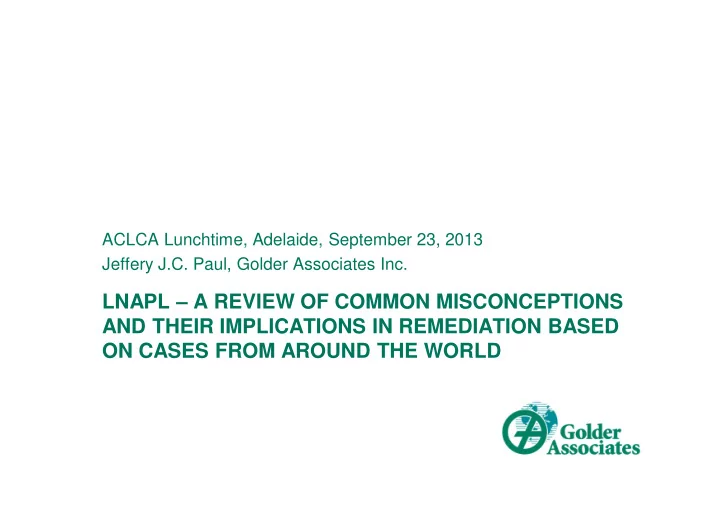

ACLCA Lunchtime, Adelaide, September 23, 2013 Jeffery J.C. Paul, Golder Associates Inc. LNAPL – A REVIEW OF COMMON MISCONCEPTIONS AND THEIR IMPLICATIONS IN REMEDIATION BASED ON CASES FROM AROUND THE WORLD
LNAPL impressions Light………. Only floats on water……………?? September 24, 2013 2
LNAPL Above and Below Water Table Hydrodynamic Case Hydrostatic Case – LNAPL is pour in olive oil first, chase like an iceberg with water Funnel Water Olive oil
LNAPL Above and Below the Water Table September 24, 2013 4
Smear Zone September 24, 2013 5
LNAPL Conceptual Model September 24, 2013 6
Unconventional LNAPL Remediation n Stop gradient migration of LNAPL n Mass reduction n Stabilization of LNAPL September 24, 2013 7
Break the chain Goal to stop migration of the free product to n off-site locations or to receptors. Technologies to break the flow. n n Typical n pump n excavate n walls n trenches n Newer processes n Air / steam lancing n Secondary effect fracturing with proppant n Brines n ISCO foam in unsaturated zone September 24, 2013 8
Gradient Breaking in Unsaturated Zone A very difficult challenge is to break an LNAPL gradient in the n unsaturated zone. An option may be to use foam technologies to “flood” the unsaturated zone with an active chemical based on a peroxide or persulphate. This has been successfully performed in The Caribbean and USA for one client by injecting hydrogen peroxide in a proprietary foam, currently the application is much more art than technology. September 24, 2013 9
Mass reduction Superoxygenated water n Surfactant / alcohol flooding (flushing) n Thermal conductive heating n Electrokinetics n Subsurface steam stripping n Denitrification n September 24, 2013 10
Break the Chain AND Mass Reduction ISCO, in particular with activated sodium persulphate n n Determining the correct oxidant and the correct amount is important to avoid interactions with site soils that will decrease effectiveness. n Generally, more persistent oxidants in permeable and saturated soils will have greater ROIs (up to 7.5 m). In fractured rock up to 30 m. n Consider potential for clogging (iron, manganese etc.) Epsom salts (magnesium sulphate) n n Slow acting n ROI less than 10 m n Persistent September 24, 2013 11
ISCO Being used in many parts of the Americas to “Break the Chain” also for n mass reduction Example from North Alabama – Use of hydrogen peroxide injected at n discrete depth intervals to break lateral LNAPL gradient in residuum soil over limestone. Successful since 2006. Key issue was the natural presence of greater than 5 mg/L Iron II. Also used in select areas for mass reduction of LNAPL September 24, 2013 12
Epsom Salts Rarely used, typically successful if there are no other carbon sources n present. Produces hydrogen sulphide. Successful projects in India, Saint Lucia, Sint Maarten, USA, UK. Example from Sint Maarten. LNAPL was slowly entering a graveyard n and towards the sea. Solution, emplace Epsom salts directly upgradient of grave yard. Outcome LNAPL gradient broken, LNAPL no longer migrating to the sea. September 24, 2013 13
Stabilization Cement – being tried again by others, not seeing long term success n Injection of activated carbon or coal dust n Hot vegetable oils or hot expelled mustard plant species n September 24, 2013 14
Coal Dust Numerous examples in Europe exist of petroleum LNAPL that does not n pass through areas with coal dust in the subsurface. Injection technique is being applied at limited sites in the Americas and India. As an example, a site in India had a combination of virgin Diesel LNAPL in one release and Diesel as LNAPL with dissolved pesticides in a second release. The release of virgin diesel resulted in migration of LNAPL towards an off-site property. Coal dust was made into a slurry and injected in rows to produce an active “wall”. Migration of LNAPL was stopped. September 24, 2013 15
Injection of Coal Dust
Hot Vegetable Product Injection Hot vegetable oil and expelled brassica species are being used in The n Americas, The Bahamas, Caribbean, UK, and to a minor extent in Bangladesh to physically stabilize LNAPL. The basis of the technology is the “nightmare” of mixing mineral oils and vegetable oils in a workshop An example is for a mineral spirits LNAPL release in Belize to stabilize LNAPL and hence preclude it entering a stream. September 24, 2013 17
Over Time – Remediation Endpoints 1974 Visual, generic hydrocarbons analysis n n 1970s Concept of free product migration offsite, focused toxic n n chemical analysis Dogmatic rules instituted with little to no basis in science Later 70s n n or application of risk assessment Some regulators/ stakeholders apply risk assessment . n 80s n 25 mg/kg TPH limit for discharges to salt water No offsite migration of free product. Risk assessment for n Currently n dissolved plume gaining acceptance No offsite migration of free product. Acceptance of n Future? residual product with applied institutional controls. n Remediation of dissolved and potentially associated released metals based on risk assessment September 24, 2013 18
Recommend
More recommend